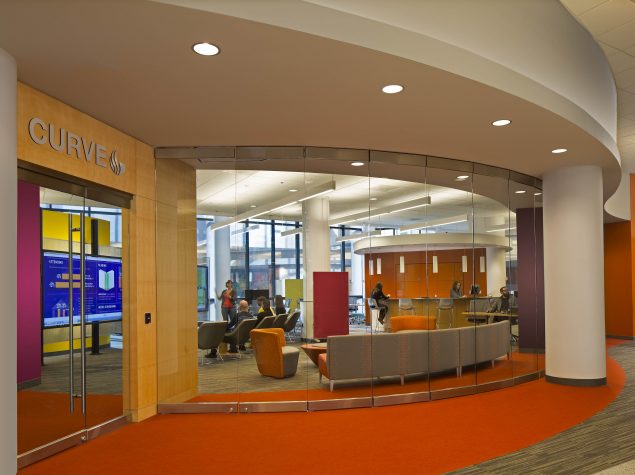Collaborative University Research & Visualization Environment
The future of research as we know it
Georgia State University
Georgia State University’s Collaborative University Research & Visualization Environment (CURVE) can be described as a space that has emerged from the ashes, previously housing endless stacks of books and videos that were rarely used by students or faculty. The rows of dusty materials acted simply as a connector from one space to another, adding little functionality to the wealth of resources and services the University Library provides. This passive space has been transformed into an engaging, technology-rich digital research center that inspires educational campuses across the nation to rethink the ways students can successfully conduct research.

Many projects start with an idea, but Georgia State’s CURVE began as a visionary dream that aspired to pursue a flexible space and program that was still unknown to the University. This uncharted path was embraced by the members of the library and design team at Collins Cooper Carusi Architects, and fueled the potential discovery of a flexible environment that adapted to the ever-changing flow of students and faculty year after year.


The challenge was to fit GSU’s dream of a visible and vital space filled with cutting-edge interactive technology into a 3,300-GSF footprint. By removing interior walls, molding space with vibrant colors, and allowing natural light to flood the space, the design team created an energetic environment and incorporated a 29-foot retractable glass partition that can be opened to embrace the public or closed to transform into a secure, more intimate format. A diversity of technology can be found throughout the space, strategically placed so the flow of movement blends the individual learning and collaboration spaces together.
This technology includes immersive large-scale displays with interactive touch, supported by visualization & modeling software, and high-end graphics processors. The most innovative piece to the technology package is the interactWall, a state-of-the-art, 24-foot-wide, touch-enabled video wall designed to support collaborative visual and data-rich research. CURVE also features several high-end computer workstations that allow students and faculty to work with and manipulate large images and data sets, and its unique design encourages interactive and interdisciplinary research and learning. Each workstation is equipped with a large display, including an 84-inch touch-enabled 4K Ultra-HD display linked to the interactWall, allowing multiple student groups to work collaboratively. Many of the technology monitors also act as a partition to offer varying levels of privacy between working groups.
CURVE acts as a catalyst amongst educational institutions across the nation, and is becoming a real-life example of what data visualization and immersive technology looks like to not only researchers, but students and educators that congregate to continue the excitement of discovery in a very new and distinctive way. The curiosity of what can and will be discovered in the space can only be answered by those who are changing the space themselves, engaging and employing the constant evolution of the learning atmosphere.
Bryan Sinclair, Associate Dean of the University Library at GSU, shares what he thinks is the future of this facility;
“We are only at the very earliest beginning of understanding how data visualization, virtual reality, augmented reality and other visual media will transform how we understand and interact with the world and each other. CURVE is unique in that it represents a partnership between the library, central IT, and institutional leadership
to develop a collective understanding of what information technology can deliver.”
